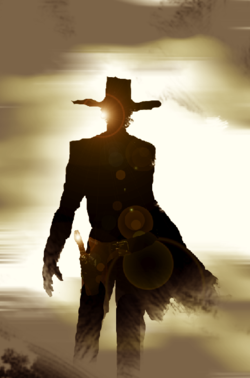Moegirlpedia would welcome your assistance in improving this article☆Kira~
As you read this article, you're welcome to participate in editing this page. Before editing, please read the wiki quickstart, editing guidelines and retrieve relevant information. We wish you a good time on Moegirlpedia. |
 By: davidwpaul | |
| Base Info | |
| Term | Western |
|---|---|
| Related Articles | Space western |
Western is a genre in media and other works. In its early stages, the term mostly referred to works about the American West in the mid-19th century and the second half of the 19th century (the Old West). After nearly a century of expansion and development, the term has exceeded its original narrow definition and gradually refers to works in popular culture that include symbols of the Old West such as cowboys.
Historical origins
The West originally meant the western region of the United States from the mid-19th century to the early 20th century.[note 1] In the first half of the 19th century, the US successfully incorporated the West into its territory through diplomacy, negotiations, and wars with foreign nations. But before the Civil War, there wee only a relatively small number of settlers and native peoples in the West, and most Americans actually still lived in the East. After the Civil War in the 1600s, with the promulgation of laws such as the Homestead Act, the completion of the construction of western railways, and the temptation of special resources in the West (such as land and gold), a large number of residents from the East region and overseas immigrants began to migrate to the West and gradually formed a unique local culture. This special era, known as the "Old West", lasted until the late 19th and early 20th centuries. With the disappearance of the wave of foreign migrants in the West, the improvement of transportation infrastructure and the substantial reduction of the native Indians, the era of the Old West gradually came to an end.
Culture and history
Golden Age of Hollywood
But the end of the history of the Old West does not mean the disappearance of Western culture itself. By the early 20th century, this special period in the West began to be unearthed by people at the time, such as the autobiography written by Laura Ingalls Wilder. The novel Little House on the Prairie received a massive reception. But the more prominent part comes from Hollywood. The Great Train Robbery from 1903 not only promoted the progress of the film industry, but was also the first "true" Western movie. During the "movies with sound" period, John Ford's famous film The Passage in 1939 once again revitalized the western genre in movies. Until the golden age of Hollywood in the 1950s, the Western genre became one of Hollywood's most popular, and its content was closer to real history, portraying wars, the pioneer years and the crimes and shootings that occurred from time to time in the history of the West. This period promoted the birth of famous cowboy figures such as John Wayne.
Spaghetti western
By the late 1950s, the decline of Hollywood led to the decline of many popular genres of the Golden Age, and the Western genre was one of them. At the same time, other countries, such as Italy, still had considerable enthusiasm for the genre. The exploration of this theme in different regions has led to the Western genre beginning to move in a more popular and symbolic direction. The sudden change in this style came from the 1960 movie Red Dead produced by Italian director Sergio Leone, creating a style known as the "Spaghetti Western". Gradually, the Western genre known to the modern public began to appear.
Western ACGN works and their categories
Because Western is styled and symbolized in popular culture, it is relatively difficult to define whether an ACGN+ work is a Western. The following is a partial categorization summary.
(1) Historical origins
Works that use the historical period defined above as the setting of the story. It may even exclude cowboys.
Wxamples:
- The Red Dead series: tells the fate of outlaws in the West from the late 19th to early 20th century.
(2) Contains symbolic elements such as cowboys
The work itself is not set in the Old West, but is considered to use obvious western elements such as cowboys and have a certain importance in the story. However, the categorization depends on the proportion of Western elements in the work. A work can contain Western elements, but not be a Western.
Examples:
- Overwatch: The animations and backstories of the heroes Cassidy and Ashe are based on the Western genre.
(3) Uses an isekai similar to Western settings
Works that use a similar Western setting but are set in a world that is completely different from actual real history. Generally overlaps with subgenres such as science-fiction western.
Examples:
- The Star Wars spin-off The Mandalorian: Many scenes are similar to the western desert in popular culture, and include bounty hunters, saloons, etc. But the overall scene is build within the fictional science fiction world of Star Wars.
(4) Spiritual successors
The content has little to do with the traditional Western genre, but it inherits its history or style. This categorization is subjective and requires appropriate evidence support.
Examples:
- Cowboy Bebop: The narrative and soundtrack of the work refer to the style of Leone's Western films. The portrayal of the protagonist Spike Spiegel and a large number of gunfight scenes are similar to the cowboys and western showdowns in popular culture.
Notes
- ↑ According to Wikipedia, the scope of this reference has changed many times in history, and the West in popular culture currently should refer to the area west of the Mississippi River, including a large area of land from Texas to the Pacific coast. Generally excludes Hawaii and Alaska.